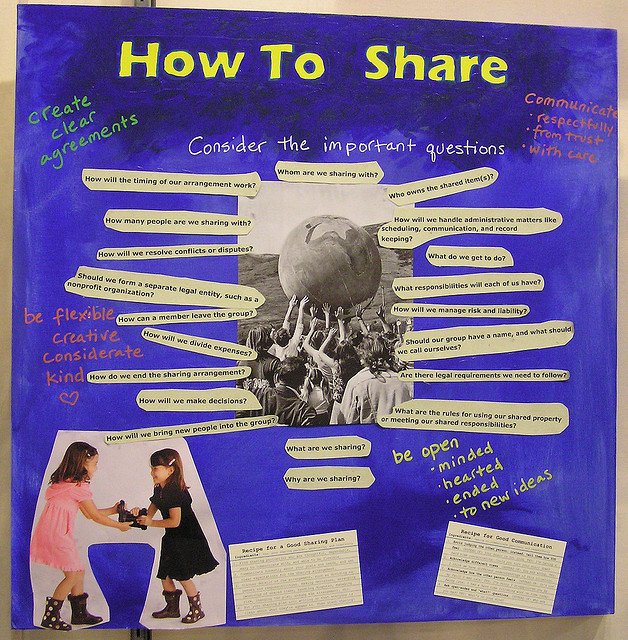In my previous post I discussed UBC’s Policy 81 on the use of teaching materials for for-credit courses. The following will make more sense if you’ve read that post!
Here I would like to talk a bit about my own views of the policy and my fears about how it may set back efforts to promote open education at UBC.
Some general thoughts on Policy 81
I may be an anomaly in this regard, but when I first read the policy I wasn’t really concerned about it. That’s probably because I already share my teaching materials using a Creative Commons CC-BY license (see here for an explanation of CC licenses). The idea of sharing my teaching materials widely amongst the UBC community wasn’t a problem for me because I had already made the decision to share them with anyone who wants to revise and reuse them, asking only for attribution.
But as I read various arguments against the policy (many of which are collated on the Faculty Association’s website, on a page devoted to Policy 81, and I’ve discussed them in some detail in my previous post), I definitely came to see the problems with the way the university has approached this issue, particularly by requiring an “opt out” procedure rather than an “opt in” one.
I can see some of the rationale behind the policy, and why it’s an “opt out” process, for things like the following examples:
1. An instructor is involved in creating teaching materials for a course for which the curriculum remains the same, or teaching materials are revised and reused several times over the years: the people who come in to teach the course later may not be able to legally use the previously-created materials without express permission were this policy not in place. Which is fine, if the original author can be contacted and give that permission, though they may not want to have to go through the hassle of doing this over and over (the author could, alternatively, give a kind of blanket permission to use the materials in any future iteration of the course, though not everyone may be comfortable with that, so a one-by-one permission-granting process may be required). Now, an opt-in type of teaching materials repository is an option, but the author of the materials may not keep the particular materials (specific assignments, etc.) up to date in such a repository. S/he may put one version in, change it for another year, forget to put that one in, and then the later instructors need to track him/her down for express permission each time they want to use the updated materials. This can be fixed with later updating of the materials in the repository, of course, but it’s an extra hassle.
2. An example I used in my previous post: instructors in a team-taught course collaboratively come up with essay topics, and if one of those instructors is part of a later team of instructors for that course and the later group wants to use one or more of those essay topics again they should, officially, ask permission. But it may be that the original author(s) are unavailable, having retired and not being easily accessible. Or, to make things more complicated (and something I didn’t address in the previous post), if the essay topics were jointly created, does one need to get permission from all of the instructors in the previous group? Probably so, but that’s a bit of an administrative headache. Now, I don’t know if the policy would cover this situation exactly, because I’m not sure what “sharing” constitutes in the policy (one has to share one’s teaching materials before they fall under the policy). But perhaps sharing with one’s team members means one is “sharing,” and thus anyone else at UBC could use the materials without asking for express permission under the policy.
3. A faculty member shares an assignment or a syllabus or some other teaching document with me, and I ask permission to revise and reuse it: is oral permission enough? Shouldn’t I get it in writing just in case any challenge comes up later by that person or someone else? Sure, this is probably a VERY unlikely scenario, but in terms of intellectual property rights and following the rules, it’s probably best to get it in writing. And if I want to reuse the materials over and over, should I get written permission over and over for each course I teach for each time I teach it, or a blanket written statement saying I can use the materials in any future course I might teach? Policy 81 would simplify all that.
Now, none of this is to say that I think Policy 81 was a good idea; it’s rather that I’m trying to think through some reasonable reasons why something like this might make sense, though ultimately I think an opt-out policy does NOT make sense, partly due to intellectual property and copyright concerns (as discussed under “copyright law” in my previous post), but also because, as I noted in the previous post, what happens when people opt out of this policy is that the idea of sharing teaching materials openly takes a step backwards.
Policy 81 and open education, open sharing of teaching materials
As noted in my previous post, a number of people have already signed up on the site where faculty members can register the courses for which they don’t want their teaching materials shared. There’s no way to tell how many others have started putting notices on their materials that they may not be revised and reused without express permission. Now, doing these things takes us back to the status quo, where the owners of the copyright on those materials must be asked permission before revising/reusing the materials. That’s not what I’m most concerned about because it’s not a change from before the Policy was passed.
What does concern me is that I fear those people may now be less willing to share their teaching materials outside of UBC, with something like Creative Commons licenses. Who knows…maybe they wouldn’t have done so anyway, but I worry that the negative hype around all of this, the fears about UBC wanting the teaching materials to make money on online courses (as noted in my previous post), the fears about that happening times ten in the wilds of the world, will lead people to just say no thank you to the idea of sharing with a CC license. And that saddens me.
A good thing about Policy 81, as pointed out by Will Engle in a conversation recently, is that it states explicitly that the university encourages open sharing of teaching materials beyond the university. In the preamble, the policy says:
UBC encourages the free and open distribution of teaching materials beyond the UBC community. To create and preserve knowledge in a way that opens and facilitates the dissemination of knowledge to the world, UBC Instructors are encouraged to utilize Creative Commons licenses, digital repositories and other open access channels to distribute their teaching materials broadly.
Of course, this isn’t required, just encouraged. But it’s a nice thing to see this encouragement enshrined in a policy–albeit, now, one which the faculty union has opted all of its members out of, as stated in my previous post.
But by making Policy 81 an opt-out policy, and with the (justifiable) reaction from the faculty union and others encouraging faculty members to opt out, to put notices on their teaching materials saying they may not be revised and reused without express permission, with the fears that others are out to make money off their materials, I wonder if some people who might have been willing to consider open licensing of their materials might now refuse to do so. This is just a wonder at this point, though I plan to do a survey soon to find out more on this (see below).
I also worry that some people may be less likely to put their teaching materials on public websites, in case that might be considered “sharing” under the policy, and thus effectively make those materials open to revision and reuse by other faculty members at UBC. Now, since the faculty union has opted all of its members out of the policy for now (and who knows what will happen in the coming months, as the grievance they filed goes through the process of being dealt with), maybe fewer people will have this concern. But I’d hate to see more of our teaching materials get siloed behind closed LMS walls for some who might have considered public websites instead.
Why do I care about possibly having less openly shared teaching materials?
Good question. The first thing that comes to mind is that I have learned so much by reading materials posted by others on public websites, all around the world. When I’m teaching a new class, I search for syllabi that might help me think about good readings. I use others’ lecture notes to help me understand complicated texts and how others approach teaching them to undergraduates. I never actually copy or distribute their materials unless they are licensed in such a way as to allow it, but just being able to see them is valuable. The more our stuff is locked away behind closed LMS’s, the less this is possible. I don’t know if anyone will ever find my teaching materials useful, but that’s just the point–I can’t know ahead of time how they might be useful to others. And I want to give back, having gotten so much value from reading what others are doing.
There’s also the argument about public funding of what we do and how this might be a reason to make our work more accessible to the public. There are already numerous governmental grant requirements to make research open access if it’s publicly funded, and one could make a case that the same should go for teaching materials. Now, the thing with teaching is that it is sometimes only partially publicly funded. I’m not sure how much of the UBC budget comes from public funds, but I do know that it’s not 100%. There are numerous other sources of funds, certainly including tuition, which would suggest that closing off teaching materials only to those students who have paid could also make sense. I suppose one could figure out the percentages and make only a certain part of one’s teaching materials publicly viewable, but this seems pedantic to me. I have chosen to go more or less 100% to open access of teaching materials (and beyond them being just viewable…more on that below), though I can see someone choosing to go 100% to just allowing students who have registered to see them. There are numerous justifiable reasons why one might not want all (or any) of one’s teaching materials publicly viewable, and I respect that. But my own choice rests partly on the idea that the public is partly paying for what I do, so it makes sense to me to let them see what I’m doing.
But I have gone beyond just posting on public websites; I also use CC licenses on my materials. So far I’ve used CC-BY on all of them–anyone is free to revise, reuse, redistribute them for any purpose, so long as I am attributed. This means that I even allow commercial use of the materials, that someone could reuse them to make a profit. Why I chose to do this has some complicated reasons behind it; I’ve tried to collate my thoughts on this blog post and the discussion in comments underneath it. Again, I do see good and justifiable reasons why one might not want to allow commercial use of their teaching materials, and I very much respect the decision of others to use CC-BY-NC or CC-BY-SA (share-alike) on theirs (again, see here for a description of the licenses).
What I would not like to see is people using a CC license that does not allow derivatives (CC-BY-ND), because there isn’t really much value in allowing others to reuse your teaching materials if they can’t be revised in any way. How often is it the case that what works in one course, at one time, in one place, is going to work exactly as is in another course, in another time and place? Yet the way our faculty union has spoken about CC licenses here, they have made it sound like “no derivatives” is the way to go:
Are there other ways to mark my work to indicate whether or how others may use my work?
Creative commons provides guidance on this, and has prepared symbols to express your preference, as follows:
 If you want to retain control: attribution-non commercial-no derivative (CC by-nc-nd)
If you want to retain control: attribution-non commercial-no derivative (CC by-nc-nd)
 If you are willing to relinquish control: attribution-share alike-non commercial (CC by-nc-sa)
If you are willing to relinquish control: attribution-share alike-non commercial (CC by-nc-sa)
The wording here suggest that with ND you somehow retain control, which sounds like a good thing to do, right? The only thing ND does that the other licenses don’t do, though, is to make sure no one can alter your teaching materials in any way (including by translating them into a different language), thereby effectively making most of them unable to be reused effectively. You don’t control exactly who uses them or how (though if you add the “non commercial” to the “no derivatives,” as suggested above, then you can make a stink if someone uses your materials for a commercial purpose). Reading the faculty union’s page on this issue, one would not even know there are other options besides these two licenses. The only links to licenses they give is to explanations of CC-BY-ND.
A survey I’m planning
Mostly my fears at this point are just fears–I don’t know what people are doing or thinking beyond the few I’ve talked to. I don’t know if people are less willing to use CC licenses, or to post their teaching materials publicly, than they were before or not. I’m also very much interested in the reasons why people might choose to do these things or not. And now that all Policy 81 has brought a lot of these issues to the forefront, I think this could be a good time to survey faculty members about their views. I’ve also put in a conference proposal to talk about this policy and what faculty attitudes towards it and towards open sharing of teaching materials are generally, and so if it gets accepted I’ll report the results there. Which means I’ll need to get ethics board approval for the survey first!
I’m thinking of asking faculty members something like the following questions:
1. Are you familiar with Policy 81? If so, describe briefly what it requires. [I want to see if there is any misunderstanding about the policy out there,]
2. Do you think Policy 81 is a good idea, or do you find it problematic? Explain why in either case. [I want to find out what the main reasons are people have for opposing it. I don’t expect many people will be in agreement with it, but who knows.]
3. Would you be willing to put some or all of your teaching materials on a public website? Why or why not?
4. Are you familiar with Creative Commons or other “open” licenses? If so, explain briefly what one or more of these allows. If not, … [I hope to have a “fork” of the survey going to a page that explains the various CC licenses]…
5. Would you be willing to allow the revision and reuse of your teaching materials by others, outside of UBC, by posting them publicly and using one of the Creative Commons licenses or another open license? Explain why or why not.
These are just my first, preliminary thoughts on what I might ask. Any suggestions welcome, as well as any comments on my concerns above!
















